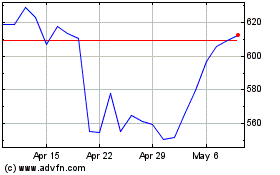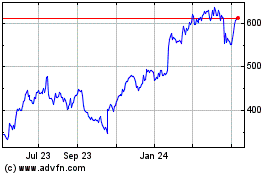Samsung's Web TVs Show Additional Ads To Drive Up Revenue -- WSJ
May 31 2016 - 3:06AM
Dow Jones News
By Min-Jeong Lee
SEOUL -- Samsung Electronics Co. is quietly adding more
advertisements to its Internet-connected televisions as it seeks
new revenue sources for its struggling TV business.
The world's largest maker of TVs by shipments added new tile ads
to the main menu bar of its premium TVs in the U.S. in June 2015
and is planning to expand the program to Europe in coming months,
people familiar with the matter said.
Samsung is working to expand its pool of advertising clients by
using agencies and its ad-sales team in New York, according to one
of these people, and by using software updates to retroactively
activate tile ads on older smart TV models.
The push is being spearheaded by Executive Vice President Lee
Won-jin, a 48-year-old ad sales expert that Samsung poached from
Google Inc. in early 2014. Mr. Lee oversees Samsung's partnerships
with companies like Netflix Inc., from which Samsung collects a
share of the revenue generated by streaming video through its TVs,
according to a person familiar with the matter.
Samsung's decision to expand its advertising initiative marks a
fresh attempt to move beyond hardware sales, a problem that it has
worked hard to overcome at its mobile division.
Samsung sells an estimated 50 million television sets a year and
has a dominant 20% share of the global market, analysts estimate.
It has invested heavily in hardware to enhance screen technology,
but that hasn't helped much to increase earnings as the industry as
a whole shrinks.
In the first quarter, global shipments of TV sets with liquid
crystal displays totaled 48.3 million units, representing a 20.9%
quarterly decline and a 6.3% year-over-year drop, according to data
from research firm TrendForce. The outlook remains bleak due to
market saturation and weak demand, TrendForce says.
Worse, Samsung's profit margins from TVs have been razor thin at
about 3% to 5% over the past few years, according to analysts'
estimates. The company doesn't break out its TV margins. And
Samsung's profit margins are under threat as low-cost Chinese
producers drive TV prices down.
"Samsung is a competent TV maker, but this industry isn't
growing anymore," said Lee Seung-woo, an analyst with IBK
Securities in Seoul. "Samsung needs to find a way to monetize the
business through content."
Competing products like Roku TVs from China's TCL Corp. and
Hisense Co. and Firefox TVs from Japan's Panasonic Corp. already
feature prominent ads.
Last year, Samsung's unit in charge of TV ads eked out revenue
of about $20 million to $30 million by selling ads and collecting
revenue from service partners, the people familiar with the matter
said. The amount is negligible compared with the 29.2 trillion
Korean won ($24.8 billion) in revenue that Samsung generated from
its TV business in 2015. The TV advertising unit is far from
turning a profit.
Samsung declined to make Mr. Lee available for an interview and
didn't comment on its TV ad sales or revenue sharing with streaming
partners like Netflix.
Expanding the tile ads program to its smart TVs in Europe could
be a challenge as Samsung seeks to persuade regulators, TV networks
and consumers who could find the unending ad streams annoying.
The ads, which appear on the home screen next to apps like
Netflix, YouTube and Hulu, open up interactive features when a user
clicks on them. In one campaign last year, a Samsung ad was used to
promote Walt Disney Co.'s animated movie "The Good Dinosaur." When
selected by the user, the ad opened a quiz that purported to match
consumers with characters from the movie.
Samsung said it positioned the ad placements in the menu bar "to
deliver relevant brands and content to consumers."
Samsung sold ads on its televisions in the past, starting in
2012 with what it now calls "integrated ads," where Samsung sells
partner ads that appear as an app alongside other apps, though they
are now only visible to users who first click on the apps
button.
"We're likely to see a host of new devices that allow users to
consume video content in various ways, which leads to thinking that
competition which has centered around picture quality, will change
significantly," said Kim Hyun-suk, the head of Samsung's TV
business, at a recent media event.
--Jonathan Cheng in Seoul and Geoffrey A. Fowler in San
Francisco contributed to this article.
Write to Min-Jeong Lee at min-jeong.lee@wsj.com
(END) Dow Jones Newswires
May 31, 2016 02:51 ET (06:51 GMT)
Copyright (c) 2016 Dow Jones & Company, Inc.
Netflix (NASDAQ:NFLX)
Historical Stock Chart
From Mar 2024 to Apr 2024

Netflix (NASDAQ:NFLX)
Historical Stock Chart
From Apr 2023 to Apr 2024
